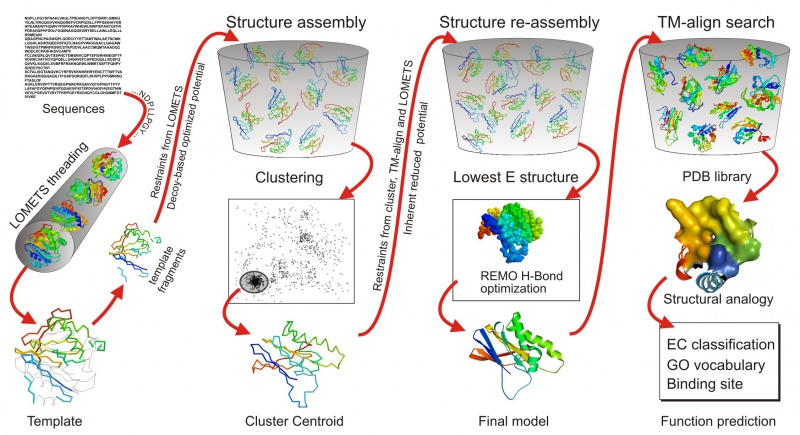Difference between revisions of "I-TASSER"
Jump to navigation
Jump to search
| (5 intermediate revisions by the same user not shown) | |||
| Line 7: | Line 7: | ||
The Wikipedia link can be found [https://en.wikipedia.org/wiki/I-TASSER here]. | The Wikipedia link can be found [https://en.wikipedia.org/wiki/I-TASSER here]. | ||
| − | :''(from the Wikipedia page) I-TASSER (Iterative Threading ASSEmbly Refinement) is a bioinformatics method for predicting three-dimensional structure model of protein molecules from amino acid sequences.<ref name="RoyNat"/> It detects structure templates from the Protein Data Bank by a technique called fold recognition (or threading). The full-length structure models are constructed by reassembling structural fragments from threading templates using replica exchange Monte Carlo simulations. I-TASSER is one of the most successful protein structure prediction methods in the community-wide CASP experiments.'' | + | :''(from the Wikipedia page) I-TASSER (Iterative Threading ASSEmbly Refinement) is a bioinformatics method for predicting three-dimensional structure model of protein molecules from amino acid sequences.<ref name="RoyNat"/> It detects structure templates from the Protein Data Bank by a technique called fold recognition (or threading). The full-length structure models are constructed by reassembling structural fragments from threading templates using replica exchange Monte Carlo simulations. I-TASSER is one of the most successful protein structure prediction methods in the community-wide [https://en.wikipedia.org/wiki/CASP CASP] experiments.'' |
[[File:I-TASSER-pipeline.jpg|800px]] | [[File:I-TASSER-pipeline.jpg|800px]] | ||
===Activity=== | ===Activity=== | ||
| + | Required software: | ||
| + | :Access to [http://jmol.sourceforge.net/ Jmol] download [https://sourceforge.net/projects/jmol/files/Jmol/ here] | ||
[https://zhanglab.ccmb.med.umich.edu/I-TASSER/example/ I-TASSER result example] | [https://zhanglab.ccmb.med.umich.edu/I-TASSER/example/ I-TASSER result example] | ||
| + | |||
| + | [https://www.rcsb.org/ RSC Protein Databank] | ||
===References=== | ===References=== | ||
| Line 20: | Line 24: | ||
<ref name="RoyNat">{{cite journal |vauthors=Roy A, Kucukural A, Zhang Y |year=2010 |title=I-TASSER: a unified platform for automated protein structure and function prediction |journal=Nature Protocols |volume=5 |issue=4 |pages=725–738 |doi=10.1038/nprot.2010.5 |pmid=20360767 |pmc=2849174}}</ref> | <ref name="RoyNat">{{cite journal |vauthors=Roy A, Kucukural A, Zhang Y |year=2010 |title=I-TASSER: a unified platform for automated protein structure and function prediction |journal=Nature Protocols |volume=5 |issue=4 |pages=725–738 |doi=10.1038/nprot.2010.5 |pmid=20360767 |pmc=2849174}}</ref> | ||
| − | a | + | <ref name="Cofactor">{{cite journal |vauthors=Roy A, Yang J, Zhang Y |year=2012 |title=COFACTOR: An accurate comparative algorithm for structure-based protein function annotation |journal=Nucleic Acids Research |volume=40 |issue=Web Server issue |pages=W471–W477 |doi=10.1093/nar/gks372 |pmid=22570420 |pmc=3394312}}</ref> |
| + | |||
| + | <ref name="Cofactor2">{{cite journal |vauthors=Zhang C, Freddolino PL, Zhang Y |year=2017 |title=COFACTOR: improved protein function prediction by combining structure, sequence and protein-protein interaction information |journal=Nucleic Acids Research |volume=45 |issue=W1 |pages=W291–W299 |doi=10.1093/nar/gkx366 |pmid= 28472402|pmc=5793808 }}</ref> | ||
| + | |||
| + | <ref name="Moult1995">{{cite journal |author=Moult, J|year=1995 |title=A large-scale experiment to assess protein structure prediction methods |journal=Proteins |volume=23 |issue=3 |pages=ii–iv |doi=10.1002/prot.340230303|display-authors=etal |pmid=8710822}}</ref> | ||
| + | |||
| + | <ref name="Battey2007">{{cite journal |author=Battey, JN|year=2007 |title=Automated server predictions in CASP7 |journal=Proteins |volume=69 |issue=Suppl 8 |pages=68–82 |pmid=17894354 |doi=10.1002/prot.21761|display-authors=etal}}</ref> | ||
| + | |||
| + | <ref name="Lomets">{{cite journal |vauthors=Wu S, Zhang Y |year=2007 |title=LOMETS: A local meta-threading-server for protein structure prediction |journal=Nucleic Acids Research |volume=35 |issue=10 |pages=3375–3382 |pmid=17478507 |pmc=1904280 |doi=10.1093/nar/gkm251}}</ref> | ||
| + | |||
| + | <ref name="REMC">{{cite journal |vauthors=Swendsen RH, Wang JS |year=1986 |title=Replica Monte Carlo simulation of spin glasses |journal=Physical Review Letters |volume=57 |issue=21 |pages=2607–2609 |pmid=10033814 |doi=10.1103/physrevlett.57.2607}}</ref> | ||
| + | |||
| + | <ref name="Spicker">{{cite journal |vauthors=Zhang Y, Skolnick J |year=2004 |title=SPICKER: A Clustering Approach to Identify Near-Native Protein Folds |journal=Journal of Computational Chemistry |volume=25 |pages=865–871 |pmid=15011258 |doi=10.1002/jcc.20011 |issue=6}}</ref> | ||
| + | |||
| + | <ref name="Fgmd">{{cite journal |vauthors=Zhang J, Liang Y, Zhang Y |year=2011 |title=Atomic-Level Protein Structure Refinement Using Fragment-Guided Molecular Dynamics Conformation Sampling |journal=Structure |volume=19 |issue=12 |pages=1784–1795 |pmid=22153501 |pmc=3240822 |doi=10.1016/j.str.2011.09.022}}</ref> | ||
| + | |||
| + | <ref name="Modrefiner">{{cite journal |vauthors=Xu D, Zhang Y |year=2011 |title=Improving the Physical Realism and Structural Accuracy of Protein Models by a Two-step Atomic-level Energy Minimization |journal=Biophysical Journal |volume=101 |issue=10 |pages=2525–2534 |pmid=22098752 |pmc=3218324 |doi=10.1016/j.bpj.2011.10.024}}</ref> | ||
| + | |||
| + | <ref name="Coach">{{cite journal |vauthors=Yang J, Roy A, Zhang Y |year=2013 |title=Protein-ligand binding site recognition using complementary binding-specific substructure comparison and sequence profile alignment |journal=Bioinformatics |volume=29 |issue=20 |pages=2588–2595 |pmid=23975762 |pmc=3789548 |doi=10.1093/bioinformatics/btt447}}</ref> | ||
| + | |||
| + | <ref name="ITsuite">{{cite journal |vauthors=Yang J, Roy A, Zhang Y |year=2015 |title=The I-TASSER Suite: Protein structure and function prediction |journal=Nature Methods |volume=12 |issue=1 |pages=7–8 |pmid=25549265 |pmc=4428668 |doi=10.1038/nmeth.3213}}</ref> | ||
| + | |||
}} | }} | ||
Latest revision as of 19:48, 19 June 2019
Welcome the I-TASSER tutorial page, a part of the Monmouth College Wiki.
Introduction
The official link to the I-TASSER website can be found here.
The Wikipedia link can be found here.
- (from the Wikipedia page) I-TASSER (Iterative Threading ASSEmbly Refinement) is a bioinformatics method for predicting three-dimensional structure model of protein molecules from amino acid sequences.[1] It detects structure templates from the Protein Data Bank by a technique called fold recognition (or threading). The full-length structure models are constructed by reassembling structural fragments from threading templates using replica exchange Monte Carlo simulations. I-TASSER is one of the most successful protein structure prediction methods in the community-wide CASP experiments.
Activity
Required software:
References
- ↑ Cite error: Invalid
<ref>tag; no text was provided for refs namedRoyNat
